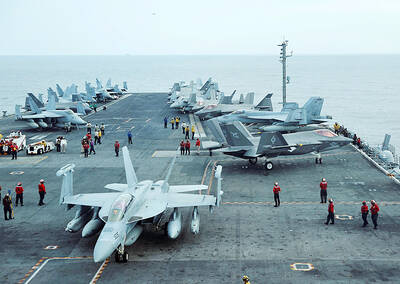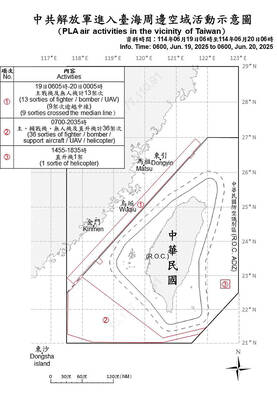A group of Japanese swimmers are scheduled to attempt a swim from Japan to Taiwan from Sept. 17 to Sept. 19, battling the swiftly flowing Kuroshio Current as they swim south before the current brings them back up north to landfall. The swimmers hope to express the Japanese people’s gratitude for Taiwan’s disaster assistance.
Six swimmers will take to the waters from Yonaguni, Okinawa Prefecture, on Sept. 17 and swim in relay fashion to Suao (蘇澳), Yilan County, over two days and two nights, said Ayahiko Matsumoto, chairman of a Japan-Taiwan athletic cultural exchange association.
Yonaguni, more specifically Cape Irizaki, is the westernmost point of Japan. Taiwan is said to be visible from Irizaki on a clear day. At a press conference, Matsumoto and the swimmers, to be led by veteran ocean swimmer Kazuya Suzuki, said in unison: “Thank you, Taiwan! We will come to you by swimming!”
The group, to be assisted by a support ship and a doctor, plans to bring three letters of gratitude to Taiwan written by the governors of Iwate, Miyagi and Fukushima prefectures, the three hardest-hit areas battered by the powerful earthquake and tsunami that hit northeastern Japan on March 11.
messages of thanks
The swimmers plan to hand the letters to President Ma Ying-jeou (馬英九) to show Japanese earthquake victims’ gratitude to Taiwanese for their generosity and compassion in the wake of the devastation, Matsumoto said.
Taiwan donated about ¥20 billion (US$261.3 million) in cash to victims of the quake, 90 percent of which came from the private sector.
The earthquake left more than 20,000 people dead or missing and triggered a nuclear crisis after the Fukushima Dai-ichi nuclear power plant suffered a meltdown in some of its reactors and radiation leaked out.
The swim will be an unprecedented challenge for the swimmers, who will swim south from Cape Irizaki before riding the Kuroshio current, which flows north from the Philippines to Japan via the ocean corridor off Taiwan’s eastern coast, to their destination. The straight-line distance between Yonaguni and Suao is about 111km, but the swimmers will need to swim about 150km in order to skirt the strong countercurrent. The Kuroshio Current will not be the only challenge for the swimmers, as they will also have to swim at night, leaving them at risk of shark attacks.
The swimmers will follow veteran fishermen’s advice by swimming in the wake of the support boat, Suzuki said.
Since sharks tend to be afraid of things bigger than them, Suzuki said, the ship will tow a giant plastic sheet and the swimmers will swim in the water above this sheet, which will form a safety barrier between them and any curious sharks.
shark-deterrent
To further ensure the swimmers’ safety, shark-deterrent equipment used by the Japan Self-Defense Forces will also be deployed, Suzuki said.
The swimmers will take turns every 30 minutes in order to allow them to accomplish the task in the allotted timeframe, he added.
The plan, inspired by baseball legend Sadaharu Oh (王貞治) and former Japanese prime minister Toshiki Kaifu, is a costly one and Matsumoto and other friends plan to raise at least ¥965,000 to fund the swim. As of Sunday, the group had raised ¥664,000.
Matsumoto, Suzuki and other members of the swim team visited Taiwan last week to tie up loose ends prior to the swim when they visited a Matsu temple in Suao to pray for blessings.

A year-long renovation of Taipei’s Bangka Park (艋舺公園) began yesterday, as city workers fenced off the site and cleared out belongings left by homeless residents who had been living there. Despite protests from displaced residents, a city official defended the government’s relocation efforts, saying transitional housing has been offered. The renovation of the park in Taipei’s Wanhua District (萬華), near Longshan Temple (龍山寺), began at 9am yesterday, as about 20 homeless people packed their belongings and left after being asked to move by city personnel. Among them was a 90-year-old woman surnamed Wang (王), who last week said that she had no plans

China might accelerate its strategic actions toward Taiwan, the South China Sea and across the first island chain, after the US officially entered a military conflict with Iran, as Beijing would perceive Washington as incapable of fighting a two-front war, a military expert said yesterday. The US’ ongoing conflict with Iran is not merely an act of retaliation or a “delaying tactic,” but a strategic military campaign aimed at dismantling Tehran’s nuclear capabilities and reshaping the regional order in the Middle East, said National Defense University distinguished adjunct lecturer Holmes Liao (廖宏祥), former McDonnell Douglas Aerospace representative in Taiwan. If

TO BE APPEALED: The environment ministry said coal reduction goals had to be reached within two months, which was against the principle of legitimate expectation The Taipei High Administrative Court on Thursday ruled in favor of the Taichung Environmental Protection Bureau in its administrative litigation against the Ministry of Environment for the rescission of a NT$18 million fine (US$609,570) imposed by the bureau on the Taichung Power Plant in 2019 for alleged excess coal power generation. The bureau in November 2019 revised what it said was a “slip of the pen” in the text of the operating permit granted to the plant — which is run by Taiwan Power Co (Taipower) — in October 2017. The permit originally read: “reduce coal use by 40 percent from Jan.

‘SPEY’ REACTION: Beijing said its Eastern Theater Command ‘organized troops to monitor and guard the entire process’ of a Taiwan Strait transit China sent 74 warplanes toward Taiwan between late Thursday and early yesterday, 61 of which crossed the median line in the Taiwan Strait. It was not clear why so many planes were scrambled, said the Ministry of National Defense, which tabulated the flights. The aircraft were sent in two separate tranches, the ministry said. The Ministry of Foreign Affairs on Thursday “confirmed and welcomed” a transit by the British Royal Navy’s HMS Spey, a River-class offshore patrol vessel, through the Taiwan Strait a day earlier. The ship’s transit “once again [reaffirmed the Strait’s] status as international waters,” the foreign ministry said. “Such transits by